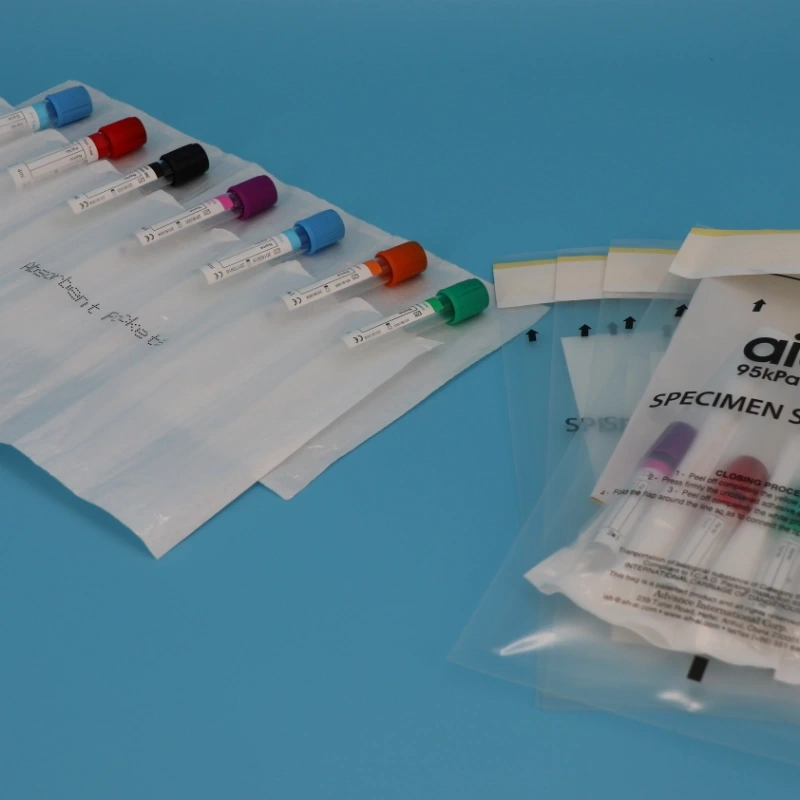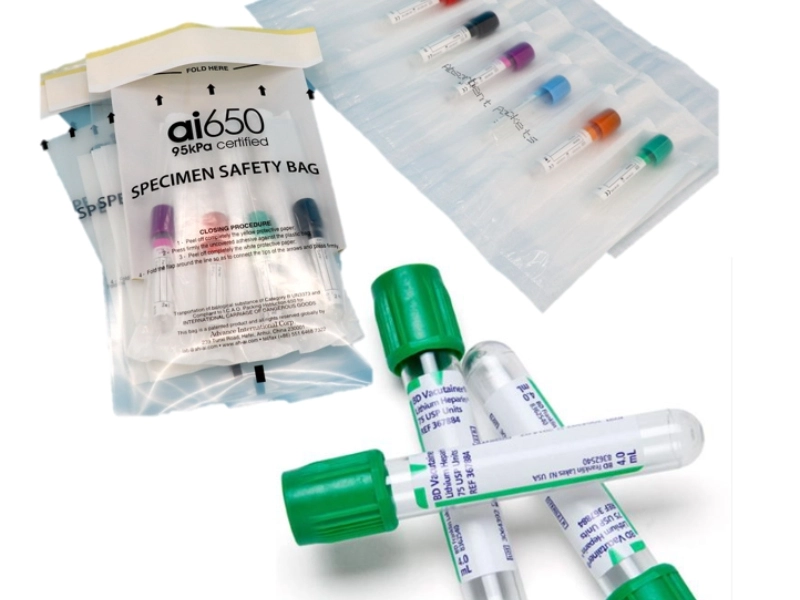Inside the World of 95 kPa Specimen Bags
Release time: 2025-10-28
In an era where global health threats demand swift and secure transport of biological samples—from routine diagnostic tests to cutting-edge research specimens—innovations in packaging are playing a pivotal role. Enter the 95 kPa specimen bag, a cornerstone of compliant shipping that ensures samples arrive intact and uncontaminated. These specialized containers, designed to meet stringent international regulations, are more critical than ever as laboratories, hospitals, and research facilities ramp up cross-border collaborations. Today, we’re diving deep into the types of these bags, step-by-step usage guidelines, key scenarios where they shine, and essential precautions to keep your shipments foolproof.
Common Bag Types and Model Examples
95 kPa bags come in various configurations to suit different sample volumes and workflows. Most feature a reclosable zipper, document pouch for manifests, and integrated absorbent sleeves to soak up any spills. Here’s a quick overview of popular types:
Item No. | Product | Size (I.D.: mm) | Size (O.D.: mm) | Additional Affiliated Parts |
| # S168283 | ai650 Safety Transport Bags, for Transportation of Medical or Clinical or Diagnostic Specimens, and UN3373 biohazard substances, as per United Nations regulations PI650 | 150mm x 240mm | 168mm x 283mm | Each bag preloaded with a 7 slotted absorbent pocket sleeve (# APS7X550) |
| # S168283N | ai650 Safety Transport Bags, for Transportation of Medical or Clinical or Diagnostic Specimens, and UN3373 biohazard substances, as per United Nations regulations PI650 | 150mm x 240mm | 168mm x 283mm | Without any absorbent material |
| # L300420 | ai650 Safety Transport Bags, for Transportation of Medical or Clinical or Diagnostic Specimens, and UN3373 biohazard substances, as per United Nations regulations PI650 | 266mm x 346mm | 300mm x 420mm | Each bag preloaded with a 7 slotted absorbent pocket sleeve (# APS7X550) |
| # L300420N | ai650 Safety Transport Bags, for Transportation of Medical or Clinical or Diagnostic Specimens, and UN3373 biohazard substances, as per United Nations regulations PI650 | 266mm x 346mm | 300mm x 420mm | Without any absorbent material |
| # APS4X320 | 4 Slotted Absorbent Pocket Sleeves, for secured Transportation of Medical or Clinical or Diagnostic Specimens, and UN3373 biohazard substances, as per United Nations regulations PI650 | 4 x each bay of L 150mm x W 40mm | 191 x 170 mm | Each pocket sleeve consists of 4 bays, total minimum absorbency 320 cc. |
| # APS7X550 | 7 Slotted Absorbent Pocket Sleeves, for secured Transportation of Medical or Clinical or Diagnostic Specimens, and UN3373 biohazard substances, as per United Nations regulations PI650 | 7 x each bay of L 150mm x W 40mm | 330 x 170 mm | Each pocket sleeve consists of 7 bays, total minimum absorbency 550 cc. |
| # AP075100050 | Absorbent Pad of absorbency 50ml, for Transportation of Medical or Clinical or Diagnostic Specimens | 75mm x 100mm | 75mm x 100mm | Absorbency of minimum 50cc. |
These models are widely available from certified suppliers and must bear the 95 kPa certification mark for regulatory compliance. Selecting the right type depends on your sample’s volume, hazard level, and transport mode—air shipments often require the most robust options.
How to Use a 95 kPa Specimen Transport Bag: A Step-by-Step Guide
Using these bags correctly is straightforward but non-negotiable for safety and compliance. Always follow the triple-packaging system: primary receptacle, secondary containment (the 95 kPa bag), and outer shipping container.
- Prepare the Primary Container: Place your biological sample in a leakproof primary receptacle, such as a screw-cap tube or vial. Secure the lid tightly and wrap in bubble wrap if needed to prevent breakage.
- Add Absorbent Material: Surround the primary container with sufficient absorbent material (e.g., vermiculite or paper) to absorb the entire sample volume in case of leakage. This is a regulatory must-have.
- Insert into the 95 kPa Bag: Slide the wrapped primary container into the bag’s main compartment. If your bag has a document pouch, tuck in shipping papers, chain-of-custody forms, or manifests—keeping them separate from the sample.
- Seal Securely: Close the zipper or heat-seal the bag, ensuring no air pockets. For added security, tape over the seal if the model allows.
- Package Externally: Nest the sealed 95 kPa bag inside a sturdy outer box or cooler with cushioning. Apply required labels (e.g., UN3373 orientation arrows) and declare the contents to your carrier.
Usage Scenarios: Where 95 kPa Bags Make the Difference
These bags aren’t just lab staples—they’re versatile tools across healthcare and research landscapes:
- Diagnostic Labs and Hospitals: Shipping patient samples (e.g., COVID-19 swabs or blood cultures) to centralized testing facilities, especially during surges when air freight is key.
- Pharmaceutical Research: Transporting clinical trial specimens from global trial sites to R&D hubs, ensuring chain-of-custody integrity.
- Outbreak Response: Field teams in remote areas using portable kits to ship infectious samples (Category B) to WHO reference labs, preventing cross-contamination in transit.
- Veterinary and Environmental Testing: Moving wildlife tissue or water samples for pathogen analysis, compliant with IMDG sea shipping regs.
In all cases, these bags reduce risks associated with pressure drops in air cargo holds, making them a go-to for international hauls
Precautions: Safeguarding Your Shipments
While 95 kPa bags are robust, mishandling can lead to delays or hazards. Here’s what to watch:
- Regulatory Compliance First: Double-check IATA PI650 or DOT guidelines—non-compliance can result in fines or shipment rejections. Always use certified bags; untested alternatives won’t cut it.
- Avoid Overloading: Don’t exceed the bag’s capacity (typically 500ml–2L per compartment) to maintain pressure integrity.
- Temperature Vigilance: For temp-sensitive samples, pair with gel packs or dry ice, but never place them inside the secondary bag. Monitor for thawing en route.
- Inspection Routine: Before use, inspect for defects like pinholes. Post-shipment, report any leaks to carriers immediately.
- Training Matters: Ensure handlers are trained—human error accounts for many incidents. In high-risk scenarios, opt for triple-layer systems to add an extra buffer.
As global trade in biological materials grows—projected to hit $50 billion by 2030—these unassuming bags are quietly ensuring safety at scale. Whether you’re a lab tech sealing a routine blood draw or a researcher racing against a viral clock, investing in quality 95 kPa transport bags isn’t just smart—it’s essential.
Stay tuned for our next post on emerging biotech shipping tech. Have experiences with these bags? Any question please click contact us!


